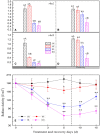Sub-high Temperature and High Light Intensity Induced Irreversible Inhibition on Photosynthesis System of Tomato Plant (Solanum lycopersicum L.)
- PMID: 28360922
- PMCID: PMC5352666
- DOI: 10.3389/fpls.2017.00365
Sub-high Temperature and High Light Intensity Induced Irreversible Inhibition on Photosynthesis System of Tomato Plant (Solanum lycopersicum L.)
Abstract
High temperature and high light intensity is a common environment posing a great risk to organisms. This study aimed to elucidate the effects of sub-high temperature and high light intensity stress (HH, 35°C, 1000 μmol⋅m-2⋅s-1) and recovery on the photosynthetic mechanism, photoinhibiton of photosystem II (PSII) and photosystem I (PSI), and reactive oxygen (ROS) metabolism of tomato seedlings. The results showed that with prolonged stress time, net photosynthetic rate (Pn), Rubisco activity, maximal photochemistry efficiency (Fv/Fm), efficient quantum yield and electron transport of PSII [Y(II) and ETR(II)] and PSI [Y(I) and ETR(I)] decreased significantly whereas yield of non-regulated and regulated energy dissipation of PSII [Y(NO) and Y(NPQ)] increased sharply. The donor side limitation of PSI [Y(ND)] increased but the acceptor side limitation of PSI [Y(NA)] decreased. Content of malondialdehyde (MDA) and hydrogen peroxide (H2O2) were increased while activity of superoxide dismutase (SOD) and peroxidase (POD) were significantly inhibited compared with control. HH exposure affected photosynthetic carbon assimilation, multiple sites in PSII and PSI, ROS accumulation and elimination of Solanum lycopersicum L.
Keywords: PSI; PSII; antioxidant system; photoinhibition; photosynthesis.
Figures










Similar articles
-
Improving Plant Growth and Alleviating Photosynthetic Inhibition and Oxidative Stress From Low-Light Stress With Exogenous GR24 in Tomato (Solanum lycopersicum L.) Seedlings.Front Plant Sci. 2019 Apr 16;10:490. doi: 10.3389/fpls.2019.00490. eCollection 2019. Front Plant Sci. 2019. PMID: 31057589 Free PMC article.
-
Toxic effects of heavy metals Pb and Cd on mulberry (Morus alba L.) seedling leaves: Photosynthetic function and reactive oxygen species (ROS) metabolism responses.Ecotoxicol Environ Saf. 2020 Jun 1;195:110469. doi: 10.1016/j.ecoenv.2020.110469. Epub 2020 Mar 13. Ecotoxicol Environ Saf. 2020. PMID: 32179235
-
Response of linear and cyclic electron flux to moderate high temperature and high light stress in tomato.J Zhejiang Univ Sci B. 2017 Jul;18(7):635-648. doi: 10.1631/jzus.B1600286. J Zhejiang Univ Sci B. 2017. PMID: 28681588 Free PMC article.
-
Molecular Mechanism of Oxidation of P700 and Suppression of ROS Production in Photosystem I in Response to Electron-Sink Limitations in C3 Plants.Antioxidants (Basel). 2020 Mar 11;9(3):230. doi: 10.3390/antiox9030230. Antioxidants (Basel). 2020. PMID: 32168828 Free PMC article. Review.
-
Photosystem I Inhibition, Protection and Signalling: Knowns and Unknowns.Front Plant Sci. 2021 Dec 1;12:791124. doi: 10.3389/fpls.2021.791124. eCollection 2021. Front Plant Sci. 2021. PMID: 34925429 Free PMC article. Review.
Cited by
-
Unveiling the role of epigenetic mechanisms and redox signaling in alleviating multiple abiotic stress in plants.Front Plant Sci. 2024 Sep 19;15:1456414. doi: 10.3389/fpls.2024.1456414. eCollection 2024. Front Plant Sci. 2024. PMID: 39363922 Free PMC article. Review.
-
Regulation of Early Plant Development by Red and Blue Light: A Comparative Analysis Between Arabidopsis thaliana and Solanum lycopersicum.Front Plant Sci. 2020 Dec 23;11:599982. doi: 10.3389/fpls.2020.599982. eCollection 2020. Front Plant Sci. 2020. PMID: 33424896 Free PMC article.
-
Differences in the photosynthetic and physiological responses of Leymus chinensis to different levels of grazing intensity.BMC Plant Biol. 2019 Dec 16;19(1):558. doi: 10.1186/s12870-019-2184-1. BMC Plant Biol. 2019. PMID: 31842774 Free PMC article.
-
The roles of photorespiration and alternative electron acceptors in the responses of photosynthesis to elevated temperatures in cowpea.Plant Cell Environ. 2021 Jul;44(7):2290-2307. doi: 10.1111/pce.14026. Epub 2021 Mar 1. Plant Cell Environ. 2021. PMID: 33555066 Free PMC article.
-
The formaldehyde stress on photosynthetic efficiency and oxidative stress response of moss Racomitrium japonicum L.Front Plant Sci. 2025 Jan 17;15:1525522. doi: 10.3389/fpls.2024.1525522. eCollection 2024. Front Plant Sci. 2025. PMID: 39898266 Free PMC article.
References
-
- Barth C., Krause G. H., Winter K. (2001). Responses of photosystem I compared with photosystem II to high-light stress in tropical shade and sun leaves. Plant Cell Environ. 24 163–176. 10.1046/j.1365-3040.2001.00673.x - DOI
LinkOut - more resources
Full Text Sources
Other Literature Sources

